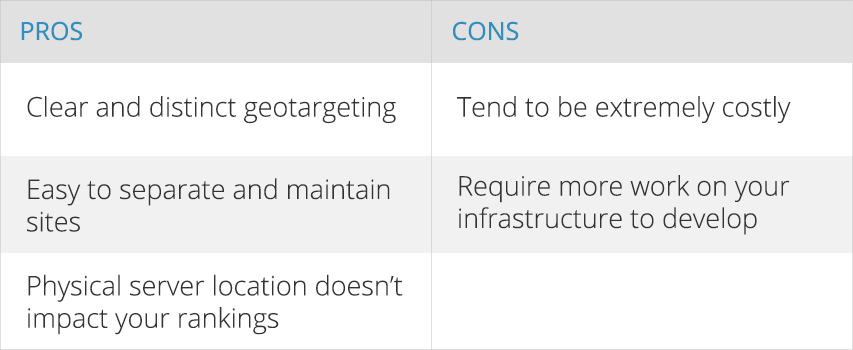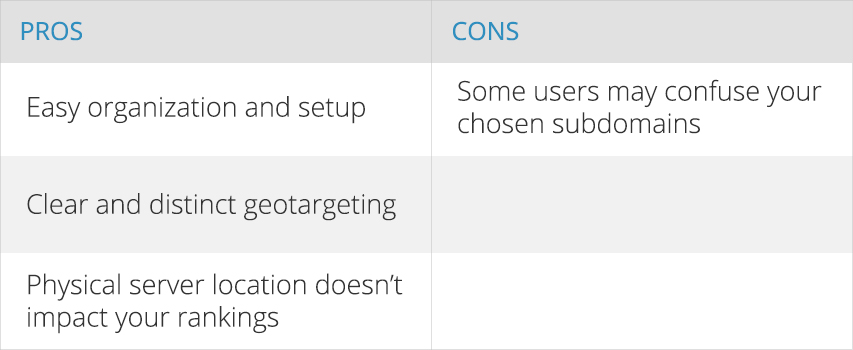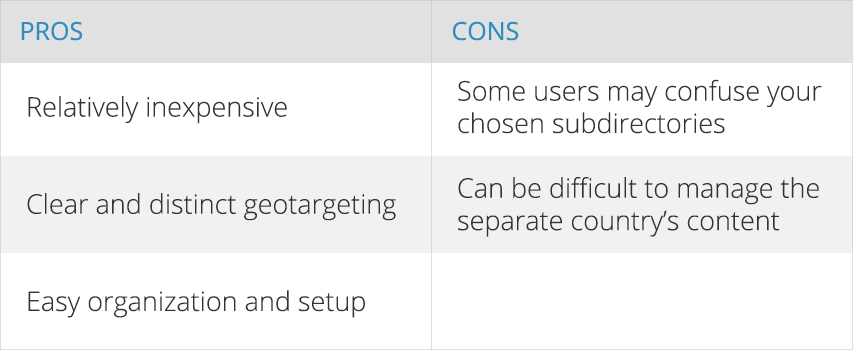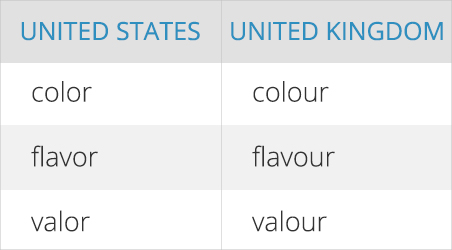International SEO Best Practices and the Hreflang Tag
Whether you’re an established brand already located around the world, a regionally-based brand with locations in just a few countries, or a national brand looking to expand to your first international country, it’s incredibly important to make sure users can find your website. That’s where international search engine optimization (SEO) comes in, and we’ve got the International SEO best practices to get you started off right.
What is International SEO?
Simply put, International SEO is the process of making your website appealing to multiple regional markets. At its roots, International SEO is the same aswith additional (and important) layers of information. This additional layer of information are most commonly limited to a country or regional location, or preferred languages. With these layers of information, Google, Yahoo and even Baidu, decipher which content is most relevant. This means that sometimes, if you’re not writing or directing content at specific markets, you may lose out on potential users who are looking for specific solutions in their language or country. But worry not, International SEO is here to help!
The Problem with International SEO
Moving into the international space is entirely possible for a national brand, but it’s important to know what steps you should be taking. Consider this:
Imagine you’re a US-based brand who is looking at expanding into other countries. While you have taken steps to prepare your brand for moving internationally, have you looked into the appropriate infrastructure with appropriate server locations? Have you considered what languages your new target markets might prefer? Have you made sure your existing site’s structure can be expanded into new regions?
If done incorrectly, moving internationally can cause a few of your website’s initial designs to become unnecessary roadblocks. To help you avoid those roadblocks, we’ve accumulated our top International SEO best practices!
International SEO Best Practices
To get the most out of your International SEO efforts, these best practices should stay at the top of your to-do list:
Determine the Best Site Structure for Your International Website
While site structure depends wholly on who your audience is and how you’re trying to reach them, three major site structure options are suggested. Each one has its distinct advantages and disadvantages. Determining the best site structure between ccTLD, Subdomains or Subdirectories all boils down to what your digital goals are.
Option 1: Country Code Top-Level Domains or ccTLDs
Country code top-level domains (ccTLDs) are top-level internet domains reserved for specific countries or sovereign states denoted by an ISO 3166-1 country code that looks like www.yoursite.us. The most common country codes are .de (Germany), .cn (China), and .uk (United Kingdom), but country codes like .us (United States), .in (India) and .ru (Russia) are not uncommon.
The major pros of ccTLDs are that they include clear and distinct geotargeting, the ease in which you can separate and maintain sites, and the fact that your physical server location doesn’t impact your rankings. However, these tend to be extremely costly and require a lot more work on your infrastructure properly develop them.

Option 2: Country-Specific Subdomains
If your company doesn’t have the time or resources available to pursue the ccTLD option, setting up a country-specific subdomain is a swift and trusted option that follows the us.yoursite.com format.
The country-specific subdomain site structure has many benefits. It allows for easy organization and setup, eliminating physical server location as a factor and offers strong geotargeting options. The only real downsides to country-specific subdomains are some users may confuse your chosen subdomains (example: users confusing es.yoursite.com as only Spanish-speaking and not pages for people from Spain) and additional costs in hosting fees that traditionally come with subdomain development.

Option 3: Country-Specific Subdirectories
Similar to country-specific subdomains, country-specific subdirectories have comparable complexity and cost of setting up and maintaining the website. Subdirectories are the simplest and most affordable option that many international companies leverage for their web presences. Structures traditionally follow the www.yoursite.com/us structure.
Country-specific subdirectories are appealing because they are relatively inexpensive due to decreased hosting costs, easy to set up, and provide strong geotargeting options. However, there are some downsides to this particular structure. Similar to the subdomain option, users may confuse your country targeting for language targeting, and it can become more difficult to manage the separate country’s content.

Localize Content for Specific International Markets
No two markets are the same. It may seem like common sense, but it’s important to remember that a potential customer located in New York City, United States, is vastly different than a potential customer in Cologne, Germany. They will use different verbiage when speaking about your industry or put emphasis on different aspects of your product. Localizing your content so it is relevant to each of your markets can make or break your digital efforts.
Even two countries who speak the same language can have large variations in the words and language they use. English speakers from the United States and English speakers from the United Kingdom are two of the first that come to mind. Here are a few examples of simple words that tend to have variations between the two English-speaking nations.

It’s important to know what the variations are and how your audience uses them. So how do you find out? Keyword research!
Double Down on Localized Keyword Research
To determine those subtle differences between selling sweatshirts in the United States versus selling jumpers in the United Kingdom, keyword research should become an integral step in your localization efforts. Researching the specific terms that each of your markets use will allow you to better connect with your users with relevant content.
Don’t be afraid to leverage free tools like Google Adwords Keyword Planner, Bing’s Organic Keyword Research Tool, or Moz’s Keyword Explorer to better understand the phrases your customers prefer. There are also many paid tools available that offer a wide variety of additional benefits!
Localize Contact or Office Location Information
Name, address and phone number (NAP Information) are a powerful way for users to see that you are local, building trust that the content on your website is meant for nearby users. NAP information also helps Google, Bing, Baidu and other search engines understand where your offices are located to determine if your content is being served to the right audience.
Localize the Available Languages on Your Website
One of the best ways to appeal to your target audience is to speak to them in their preferred language. While creating unique English experiences can be impactful on a potential user, it pales in comparison to interacting with those customers in their language. While it is true that localizing for language can be a long and arduous process, it can turn a potential customer into a lifelong customer.
Search engines can be smart when it comes to delivering the appropriate language pages to your potential customers, but it’s always nice to be able to tell them “definitively” which version is meant for which users. That’s where the hreflang tag comes in handy.
What is the Hreflang Tag?
The hreflang tag is a tag created for users to signal search engine bots the specific language and country for which each page is meant. It specifically allows you to show search engine bots the direct relationship between multiple pages that have the same content but in different languages.
For example, you may have a product page that is available in both English and French. After using the appropriate hreflang tags on each page, Google will know to show the English page to users who speak English in the United States and the French language page to users in France.
Hreflang tags can even go so far as to differentiate between similar language regions. As in our example above, these tags can be used to serve separate pages to users who speak French in Canada and users who speak French in France. By denoting both the desired language and region, you’re able to tailor content on that page to specific cultures, dialect or language differences, currency, or even estimated shipping requirements.
Here are some helpful tips when you’re looking to implement hreflang tags on your website:
Where Should the Hreflang Tag Go?
The hreflang tag can be located in three possible places:
- Within the sitemap of the website
- Within the on-page markup
- Within the HTTP header
What Does the Hreflang Tag Look Like?
There is a standard format for hreflang and it is as follows:
<link rel="alternate" href="yoursite.com" hreflang="en-us" />
<link rel="alternate" href="yoursite.com/es/" hreflang="es-es" />
<link rel="alternate" href="yoursite.com/fr/" hreflang="fr-ca" />
The important thing to remember is each page must have a self-referential tag showing the current page’s language and region, as well as the same tag on the corresponding alternate language pages.
What Languages Does Hreflang Support?
While the region codes are limited to countries using the ISO 3166-1 Alpha 2 format, languages follow the ISO 639-1 format. This means regional codes like EU (Europe), APAC (Asia Pacific) or NA (North America) are not supported.
How Can you Test Hreflang Tags?
After you have the hreflang tags implemented on your website, there are a multitude of tools to use to test if they are working as intended. Google Search Console should be your first stop. After each page is crawled, or submitted for crawl, search console can tell you if there are errors or missing tags. Other third party tools are great to use for quick troubleshooting on test pages, as well.
Moving into the international space of the digital world can be difficult, but with these best practices you can ensure your steps are in the right direction!
Let's Push Boundaries!
Is your company looking for help expanding your website into the international space? Blue Compass has digital and international marketing experts ready to help you meet your international business goals!
Blue Compass
Blue Compass is a leading team of digital experts helping brands succeed online through web design, development and digital marketing.